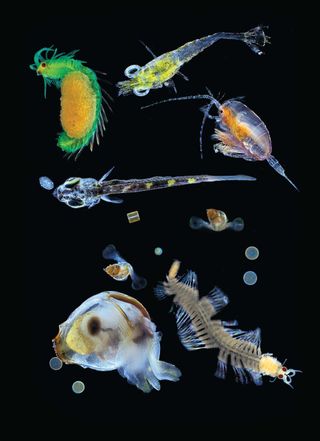
The sunlit upper layer of the world's oceans is teeming with tiny creatures that seem to have jumped off the pages of a Dr. Seuss tale, with exquisite see-through bodies, bulging eyes and an array of glowing colors. These mysterious sea characters may form the bulk of ocean life, new data from a three-year voyage suggests.
Many of the newly discovered organisms are single-celled and bigger than bacteria and viruses, but smaller than visible sea life, according to several studies published today (May 21) in the journal Science.
"The ocean has always been this big, unexplored world full of mysterious and usually big things, but a century and a half of ocean-going ships around have found all the big things," said Stephen Palumbi, a marine biologist at Stanford University's Hopkins Marine Station in Pacific Grove, California, who wrote a Perspectives piece about the expedition in the same issue of Science.
Now, researchers have cataloged many of the mysterious life-forms that "are 2 millimeters [0.08 inches] across all the way down to the parasites and viruses and the zombie vampire bacteria that feed off of them." [See Images from the Epic Sea Voyage and Wacky Creatures]
Fantastic voyage
The new work was part of an epic, three-year voyage taken by more than 150 scientists on a 36-foot (11 meters) schooner called the Tara. The team visited 210 stations throughout the world's oceans, navigating around pirates in the Gulf of Aden and braving icy storms in the Antarctic, Chris Bowler, a plant biologist at the Ecole Normale Supérieure, Institut de Biologie de l'ENS in France, said at a news conference Tuesday (May 19).
Because these creatures are invisible to the naked eye, the team teased them out by looking for their genetic material in thousands of water samples collected at those hundreds of stations.
Sign up for the Live Science daily newsletter now
Get the world’s most fascinating discoveries delivered straight to your inbox.
"We sampled an entire microscopic ecosystem covering viruses, bacteria, protists and small organisms," Bowler said. Those creatures covered a range of sizes equivalent in scale to "going from an ant to a Brontosaurus," he said.
Hidden web of life
Some of the collected DNA matched that of known species, but other genetic material pointed to thousands of completely unknown organisms. Most of these mysterious sea creatures were single-celled or simple multicellular eukaryotes, meaning they were organisms with a cell nucleus and other membrane-bound internal structures. Many of them were predators that specialized in engulfing other single-celled organisms.
Surprisingly, this mysterious trove of tiny eukaryotes is incredibly interactive, with parasites, predators and symbiotic creatures that rely entirely on each other for mutual survival all rubbing up against one another in a crazy carnival of species, Palumbi said.
"They're forming these complex but very tiny ecosystems that are probably holding the entire web of life in the ocean together," Palumbi told Live Science.
Researchers also discovered that temperature, rather than geography, was the biggest determinant of which type of microorganism tended to live where, researchers said at the news conference.
Given that climate change is predicted to warm the oceans significantly over the next several decades, entire food webs may rearrange based on those warming temperatures. Other work has already shown that fisheries tend to shift with ocean temperature, Palumbi said.
The findings may also shed light on a long-standing mystery about the ocean: how the teensy world of microbes interacts with larger sea creatures. Scientists have long known that bacteria and viruses are in a never-ending game of cat-and-mouse, eating and attacking each other in turn. But it wasn't clear whether that process was tied to food chains of larger sea creatures, such as those in which tuna devour anchovies that eat zooplankton, Palumbi said.
The newfound strata of single-celled organisms may be that missing link, with some of the eukaryotes in this middle-layer of the food web being eaten by the smallest creatures in the biggest one.
"That layer of middlemen is incredibly complicated and very diverse and very vibrant, and may well be one of the links between these two food webs that, in some senses, people thought operated very independently," Palumbi said.
Follow Tia Ghose on Twitterand Google+. Follow Live Science @livescience, Facebook & Google+. Originally published on Live Science.

Tia is the managing editor and was previously a senior writer for Live Science. Her work has appeared in Scientific American, Wired.com and other outlets. She holds a master's degree in bioengineering from the University of Washington, a graduate certificate in science writing from UC Santa Cruz and a bachelor's degree in mechanical engineering from the University of Texas at Austin. Tia was part of a team at the Milwaukee Journal Sentinel that published the Empty Cradles series on preterm births, which won multiple awards, including the 2012 Casey Medal for Meritorious Journalism.
